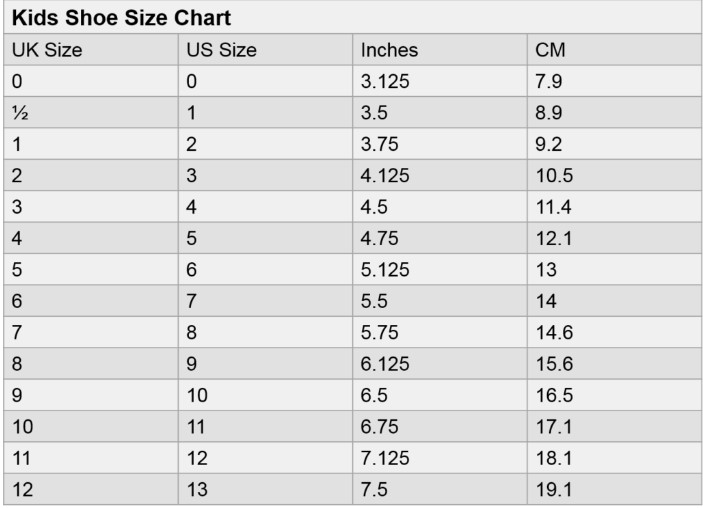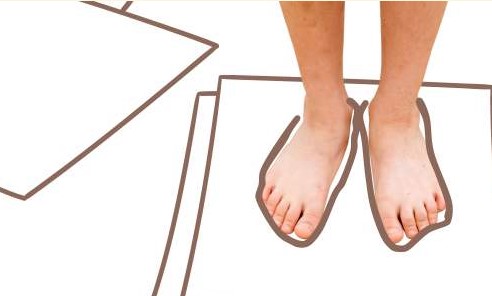Properly fitting shoes are essential for children’s foot health and overall development. Ill-fitting shoes can lead to discomfort, pain, and even long-term foot problems. As children’s feet grow rapidly, regularly measuring their feet and choosing the right size is crucial to ensure comfort, support, and healthy foot development.
Measuring your child’s feet accurately is the first step in finding the right shoes. This process involves a few simple steps that can be done at home, saving you time and ensuring a better fit for your child’s shoes.
This guide will equip you with the knowledge and tools to accurately measure your child’s feet for perfect shoe fit, all from the comfort of your own home. We’ll delve into two simple measuring techniques and equip you with expert tips for choosing the right size according to UK shoe size charts.
Why is it Important to Measure Children’s Feet?
Children’s feet grow rapidly, especially during their first few years. Shoes that fit perfectly today might pinch or be too small just a few months later. Here’s why measuring your child’s feet regularly is essential:
- Promotes Healthy Foot Development: Properly fitting shoes provide adequate support for growing bones, muscles, and ligaments. They allow for natural toe movement, which helps prevent long-term foot problems like bunions, hammertoes, and ingrown toenails.
- Prevents Discomfort and Injuries: Shoes that are too tight can cause blisters, corns, and calluses, while shoes that are too loose can lead to rubbing, chafing, and even ankle injuries.
- Improves Balance and Stability: Well-fitting shoes provide a good grip and allow for proper weight distribution, which is essential for maintaining balance and reducing the risk of falls.
- Enhances Comfort and Confidence: Comfortable shoes can make a world of difference in a child’s day. They’ll be more likely to participate in activities and explore their surroundings with confidence.
When to Measure
Frequency of foot measurement for children
Children’s feet grow at different rates, but it’s generally recommended to measure their feet every two to four months during early childhood. As they grow older, annual measurements should be sufficient unless you notice signs of discomfort or their shoes becoming too tight.
Signs that it’s time to remeasure
Keep an eye out for the following signs indicating that it’s time to remeasure your child’s feet:
- Complaints of foot pain or discomfort
- Red marks or indentations on the feet after wearing shoes
- Toes pressing against the front of the shoes
- Shoes becoming difficult to put on or take off
Use the size chart below to find the shoe size that corresponds with the measurement.

Image source: zalando-lounge
Tools Needed for Measurement:
Measuring your child’s feet requires minimal materials you likely already have at home:
- Paper: A large piece of paper, such as a sheet of printer paper or wrapping paper, will do the trick.
- Pen/Pencil: Choose a writing utensil that allows you to trace the foot outline clearly.
- Ruler or Tape Measure: A ruler or flexible tape measure with metric markings is ideal.
Steps to Measure Children’s Feet
We understand the struggle of accurately measuring your child’s feet. Complicated methods and shoe size conversion charts mixed with energetic youngsters can make measuring a challenging task.
Guesstimating sizes is a total no-go for tiny toes – plus, you want to make sure you’re spending your hard-earned pennies on the most comfortable shoes for your little one! If you can’t make it to a store, you can follow our simple guide below to measure their feet at home in easy steps:
preparation
Choose a suitable time for measurement
Pick a time when your child is calm and relaxed, preferably after a nap or when they are well-rested. This will make it easier to get accurate measurements.
Prepare a flat surface for the child to stand on
Clear a flat surface, such as a hardwood floor or a tiled area, where your child can stand comfortably during the measurement process.
Measurement Process
Trace the foot
Place the piece of paper or cardboard on the flat surface and have your child stand on it. Hold their foot in place gently and trace around it using the pen or pencil.
Measure the length and width
Using the measuring tape, measure the length from the heel to the longest toe (usually the big toe) and the width at the widest part of the foot. Make sure to measure both feet as they may differ slightly in size.
Record the measurements
Write down the measurements in centimeters or inches, noting which foot corresponds to each measurement.
Checking for the Right Fit
Comparing measurements to shoe size charts
Most shoe brands provide size charts that correlate foot measurements with shoe sizes. Compare your child’s measurements to these charts to find the appropriate shoe size.
Consideration of shoe styles and brands
Different shoe styles and brands may fit differently even if they are the same size. It’s always a good idea to try shoes on and walk around in them to ensure a comfortable fit.
Measuring Techniques: Finding the Perfect Fit
There are two main techniques for measuring your child’s feet: the footprint tracing method and the direct measurement method. Both methods are effective when done correctly. Choose the method that works best for you and your child’s cooperation level.
Footprint Tracing Method:
This method is ideal for younger children or those who might find standing still challenging.
- Prepare the Workspace: Place the paper flat on a hard surface, such as the floor or a table. Secure the paper with tape if necessary to prevent it from slipping.
- Have Your Child Stand: Ask your child to stand on the paper with their weight evenly distributed on both feet. It might be helpful to have them stand against a wall for balance.
- Trace the Outline: Hold the pen/pencil straight up and down as you trace around the entire foot outline, including the heel and all toes.
- Tip: For wiggly toes, gently press down on the top of the foot to ensure a clear outline.
- Repeat for the Other Foot: Once you’ve traced one foot, have your child carefully step aside without smudging the outline. Repeat steps 2 and 3 to trace the other foot.
- Measure the Length: Using your ruler or tape measure, carefully measure the distance from the heel to the tip of the longest toe (not always the big toe) on each traced foot.

Image source: dowihosiery
Direct Measurement Method:
This method works well for older children who can stand still and cooperate.
- Find a Flat Surface: Choose a hard, flat surface against which your child can stand comfortably. A wall works well for this method.
- Heel to Wall: Ask your child to stand with their heel firmly against the wall. Ensure their weight is evenly distributed on both feet.
- Measure to the Toes: Hold the ruler or tape measure straight up and down. Carefully measure the distance from the wall to the tip of the longest toe on each foot.

Image source: hopfrogkids
Tips for a Successful Measurement
Ensure the child is standing straight and evenly distributing weight
Proper posture during measurement is crucial for accurate results. Ensure your child is standing straight, with weight evenly distributed on both feet.
Measure both feet and use the larger measurement
Feet are not always exactly the same size. Measure both feet and use the larger measurement to ensure a comfortable fit.
Account for growth and shoe type
Children’s feet can grow quickly, so it’s essential to leave some room for growth when choosing shoe sizes. Additionally, consider the type of shoe – athletic shoes may require a different fit than dress shoes.
Conclusion
Regular foot measurements are essential for ensuring your child’s comfort, support, and healthy foot development. Properly fitting shoes can prevent foot problems and promote proper posture and walking mechanics.
Choosing the right shoes based on accurate measurements is key to ensuring your child’s feet are well-supported, comfortable, and developing properly.
Frequently Asked Questions (FAQs)
You can measure your child’s foot size at home using a piece of paper, a pencil, and a measuring tape. Have your child stand on the paper while you trace around their foot. Measure the length from the heel to the longest toe and the width at the widest part of the foot using a measuring tape. Compare these measurements to shoe size charts to find the right fit.
You can get your child’s feet measured at local shoe stores, department stores, or children’s specialty shoe stores. Some stores have trained staff who can assist you in finding the right shoe size for your child.
Kids’ foot sizes refer to the range of shoe sizes designed specifically for children. These sizes typically start from a toddler size 4 and go up to a youth size 7 or 8, depending on the brand and style of the shoe.
To measure kids’ feet in centimeters (CM), place a piece of paper on a flat surface and have your child stand on it. Trace around their foot and measure the length from the heel to the longest toe using a measuring tape. Record this measurement in centimeters. Repeat the process for the width at the widest part of the foot and note down the measurement in centimeters as well.
